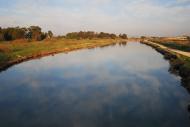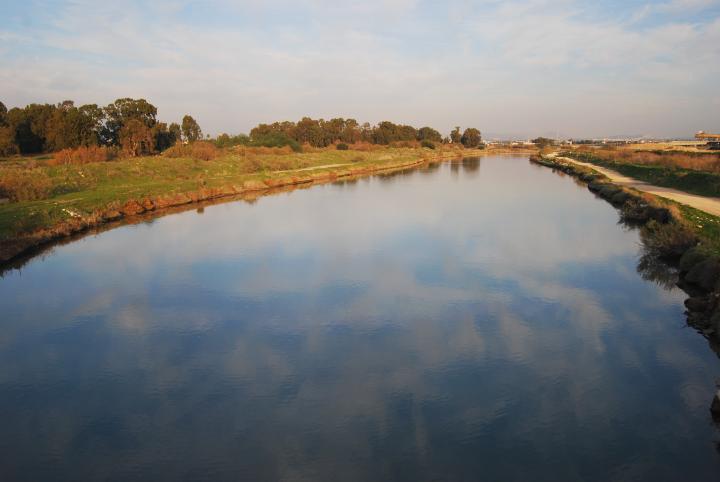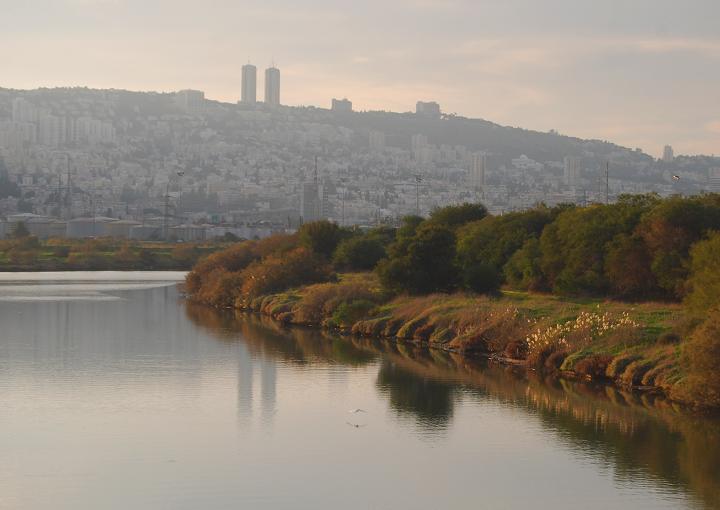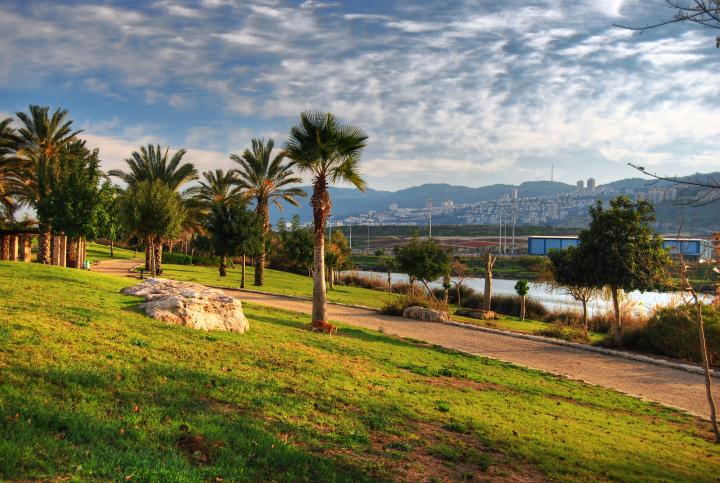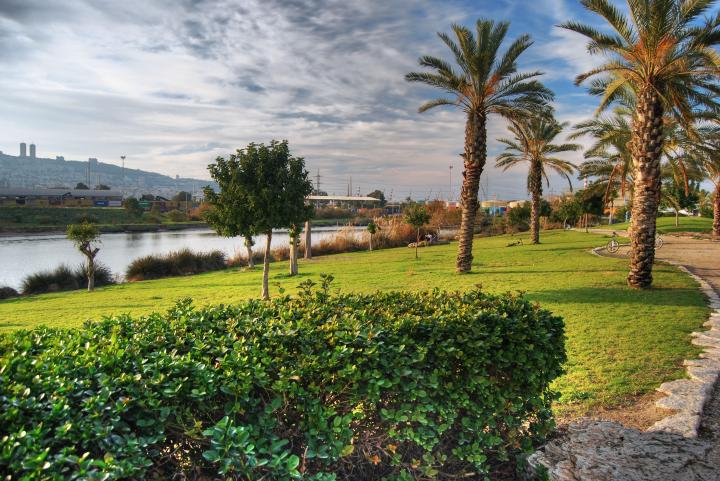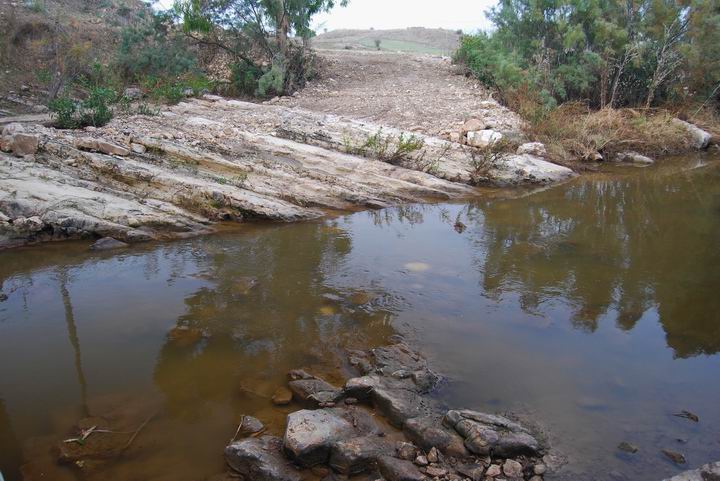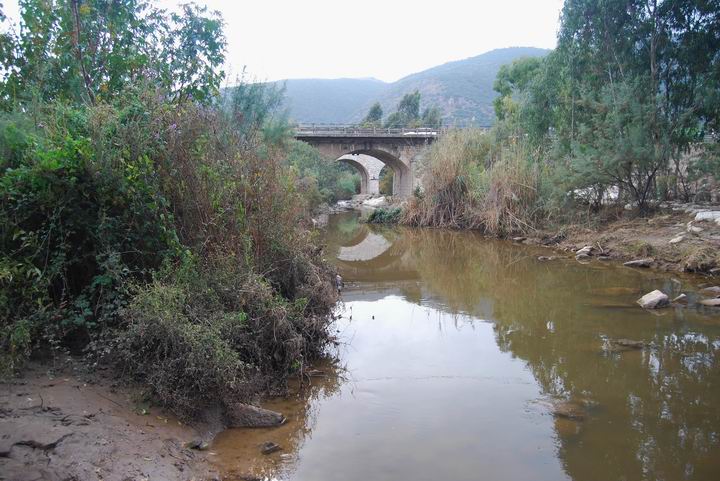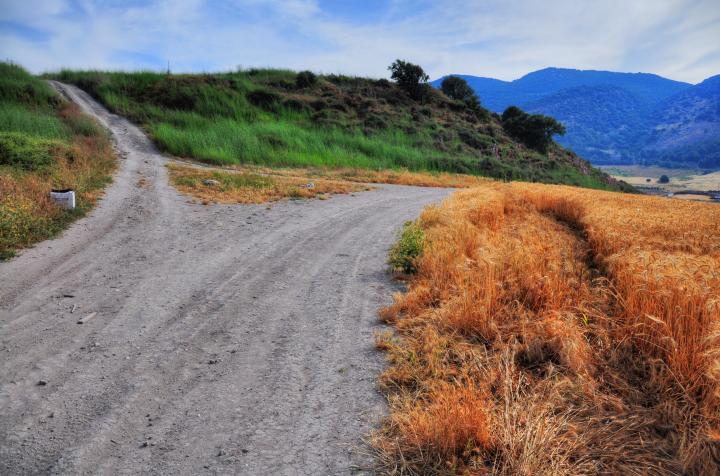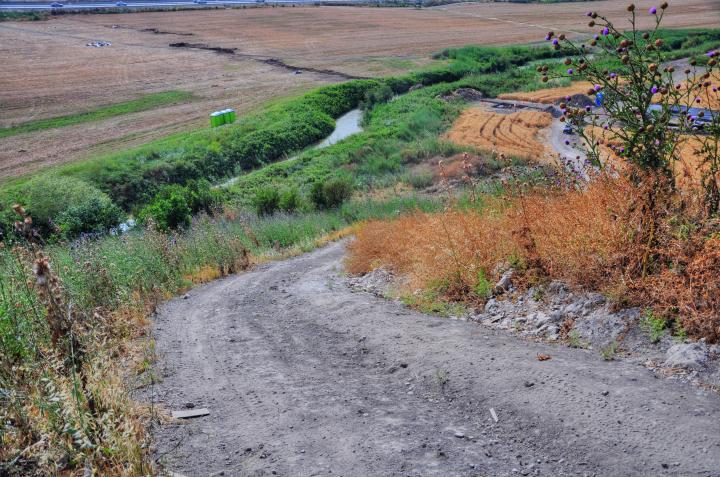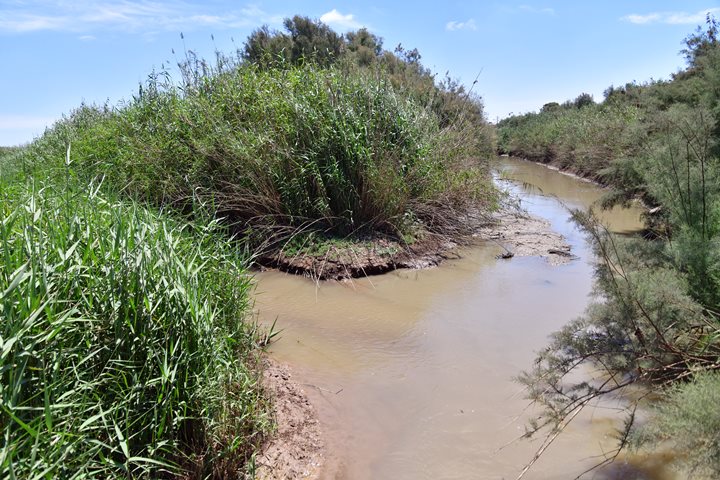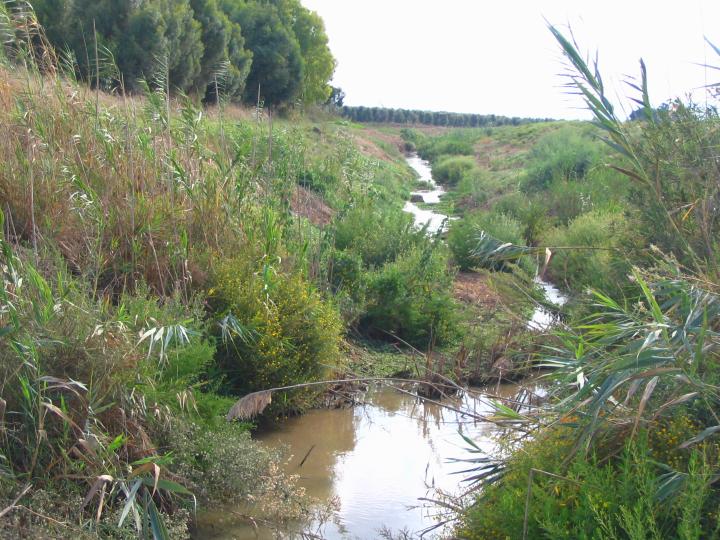One of the the largest rivers in Israel. Many Biblical events and sites are located along its banks.
Home > Sites > West Galilee > South > Kishon River
Contents:
Background
Location
Roman map
History
Photos
Biblical
Links
Etymology
Background:
The Kishon (Qishon) river is one of the largest in Israel. Its drainage basin includes an area over 1000 square KM, where one third of this area is in Jezreel valley.
The river is composed of several sections, which differ in nature:
-
South Eastern basin – starts from the north-west side of the Gilboa mountain ridge and the north of the hills of Jenin. At this section the Kishon, and the other creeks that join it, are small, shallow, creek.
-
North Eastern basin – the area south of Nazareth. At this area there are several small creeks that flow into Baruch lake and are dry most of the year.
-
Baruch lake – in the center of the Jezreel valley (also called Kishon lake).
-
Baruch lake to Tell Kassis – total 15KM. The Kishon flows at a low 15% descent within a narrow channel.
-
Tell Kassis to Tell Me’amar (Geva) – total 5KM. This section is narrow and shallow.
-
Tell Me’amar to a joint with Sepphoris creek – total 6KM. This section is narrow and shallow.
-
Sepphoris creek to Mediterranean sea – total 6KM. This is the only wide section – 10M wide/1.5M deep until the Gedora creek junction, and 20M wide/2M deep to the sea. Unfortunately, this section is also polluted and smelly due to the heavy industry along its course.
Major Biblical events happened along the river and dozens of ancient sites were constructed around the river banks. This web page summarizes these events and sites.
Judges 5 21: “The river of Kishon swept them away, that ancient river, the river Kishon”.
Location:
The aerial map of the southern side of the Galilee is seen below. The Kishon river is shown in blue, flowing from south-east (lower right) to the bay of Haifa (top left).
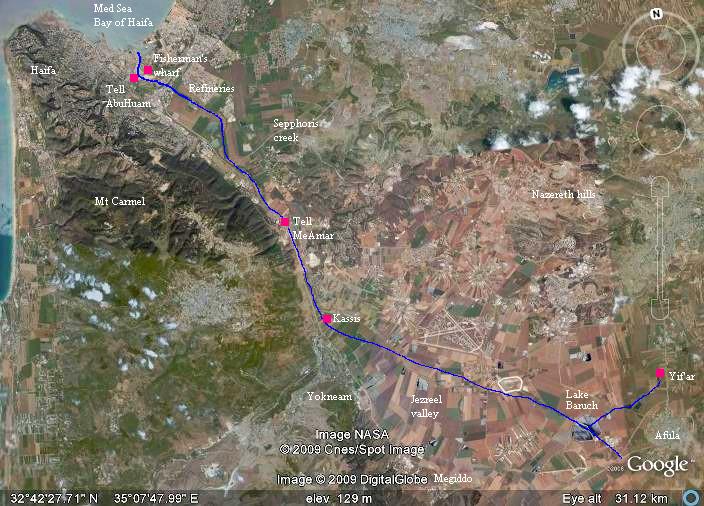
Kishon River in the Roman road map:
The Peutinger Map (Tabula Peutingeriana) is a medieval map which was based on a 4th C Roman military road map. The map shows the major roads, with indication of the cities, and geographic highlights (lakes, rivers, mountains, seas). Along the links are stations and distance in Roman miles (about 1.5KM per mile).
In the section shown below is the area of the Galilee, drawn in a west-up direction (the Mediterranean sea on the top, and Syria on the right).
The Kishon river is seen as a winding line (marked with a blue marker). It flows from the mountains of the Galilee (Nazareth and Gilboa) into the Mediterranean sea, crossing the coastal Roman road from Tyre and Acre (“Ptolemaide”) through Dor (“Thora”) to Caesarea. The ancient map is not accurate but it shows the importance of the river.
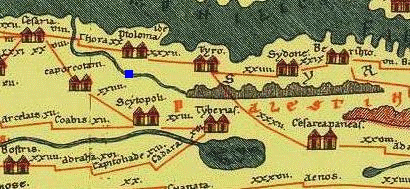
History:
-
Biblical – Shichor Livnath – “the white Nile” – “Glass river”
The first Biblical reference of Kishon river may have been in the description of the border of the tribe of Asher. Joshua 19 24-26: And their border was… and reacheth to Carmel westward, and to Shihorlibnath“. Scholars, such as Yohana Aharoni, identify this name as Kishon river. “Shihor” as the Egyptian name of a river (as per Isaiah 23 3) , and Livnath (means in Hebrew: white) as the name of ancient city of Tell Abu-Huam. This Tell (populated from Late Bronze through Byzantine period) lies near Haifa’s fisherman’s wharf and was a crossing point of the Way of the Sea over the river, and may have given its ancient name – the “white river” or “white Nile”.
Why white? Perhaps due to the white sands near the mouth of the river? Another theory is “white” means white glass. The discovery and perfection of the glass manufacturing process is attributed to the Phoenicians, and the bay of Haifa is considered as the plausible site of this discovery – one of the most important inventions in modern life. Even the famous Roman author and naturalist Gaius Plinius (Aka Pliny the elder, 23-79AD) who visited this area in 70AD, speculated that the glass as invented in the bay of Haifa near Acre. Josephus Flavius, the Jewish General turned Roman historian, wrote in his 1st C book (2 Wars10 2) about the glass manufacturing in the bay of Haifa. A hint on glass manufacturing is even included in Moses’ blessing of Zebulun (Deuteronomy 33 1, 18-19: And this is the blessing, wherewith Moses the man of God blessed the children of Israel before his death….And of Zebulun he said… for they shall suck of the abundance of the seas, and of treasures hid in the sand”).
-
Biblical – Great events
The Kishon river is named in two major Biblical events –
Deborah’s battle (Judges 5 “The river of Kishon swept them away, that ancient river, the river Kishon. O my soul, thou hast trodden down strength”)
Elijah’s slaughter of the Baal prophets (1 Kings 18: and Elijah brought them down to the brook Kishon, and slew them there”).
- Ottoman period
An illustration of the ruins of the river, dated 1882, was published a book by CH. W. Wilson , one of the PEF explorers. The title: “The river Kishon”, with subtitle: “As it appears after the rainy season, where it flows through the narrow pass called Wady el Kasab (Valley of Reeds), which leads from the great plain of Esdraelon to the plain of ‘Akka. Oleanders flourish here, and many small birds build their nests.”.
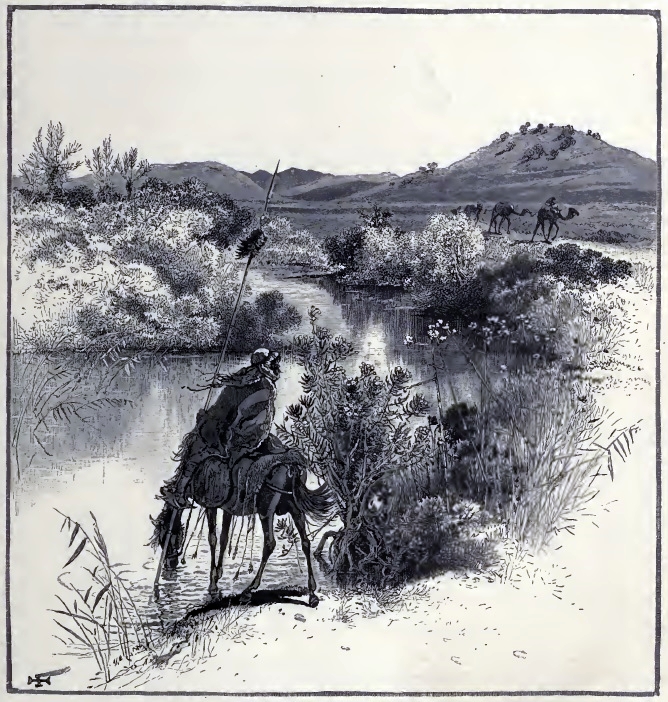
Ch. W. Wilson, Picturesque Palestine, 1882, Vol III P. 97
-
Modern periods
The lower section of the river is polluted, due to illegal sewage on the upper sections and the heavy industry in the bay of Haifa – the oil refinery and their associated chemical factories. Huge efforts and funds were invested in the last 10 years, ever since the “green” organizations started to force a clean up and preservation of the nature life, and as a result of sickness of divers in the river . Parks were constructed along the river and the river was cleaned and drained.
Although Israel is a dry country, flooding along the river occurs for short periods during wet winters at an average rate of 6 years.
Photos:
(a) Old Bridge near Haifa:
A view of the river at its widest section is seen below – 20M wide and 2M deep. This point is located on the east side of the old (closed) bridge near the Haifa fisherman’s wharf .
Click on the photo to view it in higher resolution…
This drone photo shows an aerial view of the same section, 110m above the bridge:
A view towards the west from the same point. Mount Carmel and the city of Haifa is seen in the background. Beyond the river bend was a large ancient city – Tell Abu Huam – which may have been referred in the Bible as a site called “Livnath” which was on the south border of the tribe of Asher. The Tell was excavated many times since the 1920s, and then razed while developing the industrial zone near Paz bridge. Three anchorage piers and two cemeteries were identified around the walled city, which rose 8M above the river.
The next photo was captured by a drone, showing the same section from a height of 110m above the bridge. The port of Haifa, and the bay of Haifa, are seen on the far right background. Park Kishon and the Fishermen Wharf, which are featured in the next section, are seen in the right side.
(b) Park Kishon – Fisherman’s Wharf:
On the west side of the river, near the fisherman’s wharf, is a new park (opened in 2000). The area of the recreation park is 33 Dunam (over 3 Hectares). It stretches along the north bank of the river.
A view of the park, the river and Carmel in the background.
Another view of the river. The tower in the center of the top of Carmel is the University of Haifa.
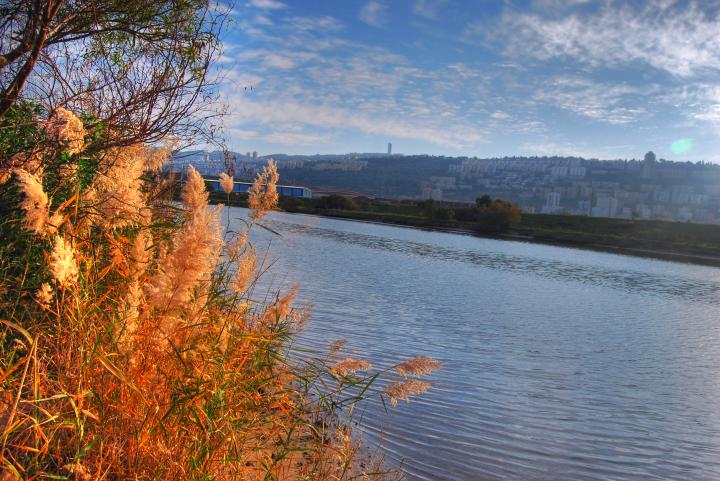
(c) Kishon Park – Geva:
The Kishon river is today a small creek on its eastern side, 17KM away from the mouth of the river, near Tell Me’Amer (identified as Biblical Geva). A photo of the eastern section is seen below, taken in late November before the flooding of the winter season (which normally happens during December through March). The Tell (ancient mound) is seen in the center background.
A view towards the south: the Turkish bridge is seen in the background, and behind it is Mount Carmel. The Turkish railway, from Haifa to Hejaz, used the south bridge to cross the Kishon.
(d) Tell Kassis
A view of Tell Kassis, near Yokneam, is seen below. The Kishon creek flows around the mound. In the right background is the edge of Mount Carmel.
Two major Biblical events happened here or near the site –
-
Elijah slaughters the Baal prophets – According to the Biblical description, this may have been the area where Elijah slaughtered the 450 Baal prophets. 1 Kings 18: and Elijah brought them down to the brook Kishon, and slew them there”
-
Battle of Deborah – The site witnessed the victory of Barak Ben-Abinoam over the Canaanites during the battle of Deborah and Barak. Judges 5 “The river of Kishon swept them away, that ancient river, the river Kishon. O my soul, thou hast trodden down strength”.
From the southern side of the mound, once the location of the Bronze age defense walls, is a view of the narrow Kishon.
(e) Lake Baruch
Lake Baruch is an artificial lake, created by a dam in the 1950s to form as a reservoir for the farming villages in the center of the wide fertile Yizreel valley
Near lake Baruch, a number of streams join together to form the Kishon river. One of them is called Mizra Creek. It brings water from the foothills of Nazareth. Another is Adashim creek, bringing water from Tel Yifar near Balfouriya. Another stream (Keyni) flows from Megiddo area. Yet another stream comes from the Jenin valley.
This photo shows the confluence near lake Baruch.
(f) ‘Adashim Springs
There are a number of springs around Tell Yifar (Balfouriya) , called the “‘Adashim” springs. These are one of the sources of the Kishon creek, which flows through the heart of the Yizreel (Jezreel) valley. At this section the creeks are narrow.
Biblical:
Joshua 19:24-26
This description of the region of the tribe of Asher may have included an Egyptian name of Kishon – Shihor Libnath.
“And the fifth lot came out for the tribe of the children of Asher according to their families. And their border was… and reacheth to Carmel westward, and to Shihor Libnath“;
Judges 4, 7-13- 16-24:
Barak ben-Avinoam trapped the army and Chariots of Sisera, the General of the Canaanite King Jabin, and defeated him. Barak used the flooding of the Kishon to overcome the mighty army equipped with chariots. For more information on the battle of Deborah’s see “Barak and Deborah“.
“And I will draw unto thee to the river Kishon Sisera, the captain of Jabin’s army, with his chariots and his multitude; and I will deliver him into thine hand….”
“And Sisera gathered together all his chariots, even nine hundred chariots of iron, and all the people that were with him, from Harosheth of the Gentiles unto the river of Kishon”.
“But Barak pursued after the chariots, and after the host, unto Harosheth of the Gentiles: and all the host of Sisera fell upon the edge of the sword; and there was not a man left”.
“And the hand of the children of Israel prospered, and prevailed against Jabin the king of Canaan, until they had destroyed Jabin king of Canaan”.
Judges 5, 1+21:
The Judge Deborah sang the famous song after the victory over Sisra:
“Then sang Deborah and Barak the son of Abinoam on that day, saying,” …
“The river of Kishon swept them away, that ancient river, the river Kishon. O my soul, thou hast trodden down strength”.
Isaiah 23 3:
Shihor (Shichor) means “River” or “Nile”:
“And by great waters the seed of Sihor, the harvest of the river, is her revenue; and she is a mart of nations”.
1 Kings 18 40:
This is the text on Elijah the prophet and the slaughter of the Baal prophets. King Ahab contested the prophet against his false prophets, and Elijah -with the help of the true God – prevailed. He slaughtered the 450 Baal prophets in the Kishon riverside.
“Take the prophets of Baal; let not one of them escape. And they took them: and Elijah brought them down to the brook Kishon, and slew them there”.

Imagined AI Illustration by Craiyon– Kishon river at Mt. Carmel foothills
Links:
- Kishon River authority (Hebrew)
- Kishon river – from poison to Pristine (thanks for Lin on her update)
- Drone Aerial views – collection of Biblical sites from the air
Etymology (behind the name):
-
Kishon – unknown source of the name. Perhaps it was named after King Saul’s father Kish Ben Aviel of Benjamin, whose name may have been based on the Akkadian word of “gift”. Thus, the name of the river may be interpreted as the “gifted river”.
-
Libnath (Livnath) – Perhaps the ancient name of the river. Means in Hebrew: white. Scholars identify the site in Joshua 19 24-26 named “Shihor Libnath” as the name of the river, since “Shihor” is a long river in Egyptian (the Nile is the shihor of Egypt). This may refer to the glass manufacturing which was invented in the bay of Haifa, according to early and modern scholars. So the meaning of the name of the river can be “the white Nile”, “white river”, “glass river” or “glass Nile”.
-
Haifa River – the Crusaders’ name of Kishon river
-
Naher el-Muqta – the name of the river in Arabic
BibleWalks.com – touring the sites of the Holy Land
Tell Zavat<<<–previous site—<<<All Sites>>>— next West Galilee site—>>> Yehi’am fortress
This page was last updated on June 2, 2024 (add confluence)
Sponsored links:
